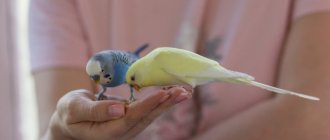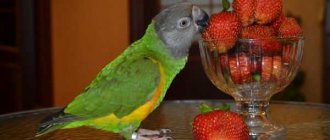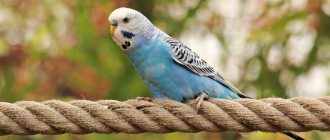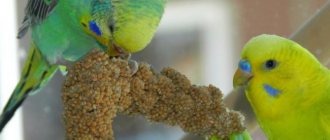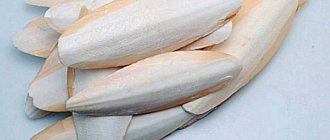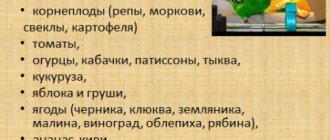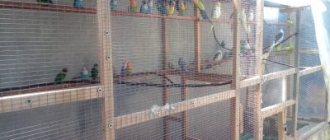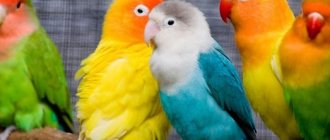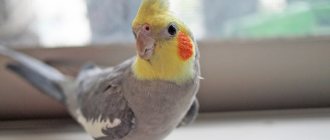- home
- Parrot
- Treatment
04/20/2019 Ornithosis of parrots is an extremely serious illness that can affect not only feathered friends, but also their owners. That is why it is important to remain vigilant and immediately contact a veterinarian or ornithologist at the first signs of illness. However, in order to be alert and not get into an unpleasant situation, it is necessary to be informed about the main symptoms and methods of preventing the disease.
What kind of disease is psittacosis?
Psittacosis, also known as chlamydia or psittacosis, is a type of viral disease that primarily affects the respiratory system and intestines of birds. This diagnosis is common in the animal world - about a hundred species families of birds are susceptible to it, which includes budgerigars. It is not uncommon for people to become infected from pets.
When a bird becomes infected with ornithosis, it subsequently acts as a carrier of the virus and transmits it through particles of infected dust, secretions from the mucous membrane or excrement.
It is worth noting that the psittacosis virus is extremely viable and can survive even at low ambient temperatures. What is surprising is that the infection mainly affects young birds, while more mature birds show resistance to the pathogen.
Features of the pathogen
Psittacosis is caused by bacteria of the genus Chlamydiophila, which is an intracellular parasite. It has the shape of a ball and is capable of multiplying only inside the cell; it is selective to tissue types, affecting the lining of blood vessels, alveoli and tissue of the genitourinary tract. Their peculiarity is their long-term preservation in the environment; they are able to survive in water for more than 2 weeks, in nests and droppings for more than 2 months, and when frozen they can be preserved for years.
High temperatures are unfavorable for chlamydiol. At room temperature, the bacterium dies within 2 days, and when boiled, it dies in five minutes.
The parasite has fundamentally different forms:
- Reticular - adapted for coexistence inside the cell and has good sensitivity to antibiotics.
- Elementary - similar to sporulation, located outside the cell and not affected by drugs. It adapts well to environmental changes and can inhibit its own protein synthesis under unfavorable conditions.
How can a parrot become infected?
Infection with psittacosis occurs by airborne droplets or through food. To penetrate the body, the pathogen needs to get on the mucous membrane of the parrot. Having picked up the virus, the bird immediately becomes a carrier of the infection and quickly transmits it to others during the process of sneezing, coughing or bowel movements.
Most often, distribution occurs in environments where several individuals of the same species exist nearby. The droppings of an infected parrot enter the respiratory tract of healthy parrots, and they quickly become infected. Once a bird has suffered the disease, it becomes a carrier of the disease until the end of its days.
Bird flu in parrots
Bird flu is a dangerous infectious disease. Bird flu is carried by wild ducks and other birds. Bird flu is especially dangerous for parrots kept in outdoor aviaries. It occurs in birds in two forms: weak and severe. Symptoms of a weak form are: reduction in egg production, lethargy, loss of appetite, fragility and loss of feathers. And if a parrot experiences: thirst, weakness, increased body temperature, fragility, loss of feathers, damage to the respiratory system, digestive upset and damage to the nervous system, then these are already signs of a severe form of the disease.
Bird flu is extremely dangerous and spreads very quickly. The only way to prevent an epidemic is to destroy as soon as possible all infected birds, as well as those birds that were in contact with sick birds.
Symptoms of infection
Symptoms of ornithosis in parrots are quite numerous and characteristically expressed, which greatly facilitates the diagnosis of the disease. The main symptoms of the disease, manifested during the acute stage of the disease, most often include:
- Fever;
- convulsive movements (in critical cases - paralysis);
- stool disorder - droppings become liquid and greenish in color, sometimes with blood;
- depressed state;
- lack of appetite;
- difficulty breathing, which subsequently leads to spasms;
- discharge of mucus from the beak and eyes;
- loss of coordination of movements.
Parrots in the acute stage of psittacosis, which usually lasts 5–8 days, remain half asleep all the time and have a ruffled appearance with protruding feathers. They do not fly and their movements are slow. However, the disease can also occur in a latent form, without obvious warning signs.
The acute form of the disease is preceded by an incubation period lasting 1–5 days, during which symptoms appear quickly and correspond to the clinical picture of the disease. Unfortunately, the mortality rate from psittacosis is 30% and occurs 1-2 weeks after infection if proper measures are not taken in time. However, do not despair: if treatment arrives in time, the acute form turns into a subacute form, the course of which is already safe for the bird and is asymptomatic.
Encephalitis or West Nile fever in parrots
Encephalitis or West Nile fever is caused by an RNA virus of the Alphavirus genus. Encephalitis is transmitted by mosquitoes. The virus circulates in the mosquito-bird cycle. The virus is transmitted from animals to humans by many species of mosquitoes of the genus Culex and Aedes .
After the initial infection from mosquitoes, birds can further spread the infection through pecking and cannibalism.
The incubation period ranges from several days to 2-3 weeks. The disease may be preceded by loss of appetite, lethargy of the bird, exhaustion, and diarrhea for several days. The disease itself begins acutely with a decrease in body temperature (below 40 degrees) and is accompanied by chills in the bird (feathers shaking), convulsive manifestations, and cuts to the limbs.
People's natural sensitivity is high.
Encephalitis usually affects children under 15 years of age or adults over 50 years of age. In older people, sudden high fever, headache, vomiting, lethargy, rapidly progressing stiffness to the neck, convulsions, muscle spasms, tremors, stupor and coma are observed. In children, encephalitis manifests itself as fever, headache and vomiting for 1-2 days. After apparent recovery, painful neurological conditions may persist for a long time. Although very rare, Eastern Equine Encephalitis virus can cause death (30%-60% mortality rate was once recorded).
Diagnosis of the disease
In order to make a correct diagnosis when the first symptoms of psittacosis appear, it is important to contact a specialist as soon as possible. The veterinarian will collect the necessary indicators and conduct laboratory tests to determine the presence of the pathogen.
Do not hesitate: even at early signs of illness in a parrot, it is better to isolate and test all individuals that were in close proximity to an infected fellow.
Diagnosis is carried out on the basis of blood and droppings tests, scrapings from the throat, and mucous membranes. To establish the final fact of the disease, a comprehensive clinical study of the obtained materials is carried out.
Pseudotuberculosis in parrots
This disease is caused by Pasteurella pseudotuberculosis, which is found in parrots. As a rule, pseudotuberculosis occurs in birds against the background of other diseases, such as chronic intestinal disorders. The first signs of the disease that you need to pay attention to are: depression, ruffled plumage, unnatural head position, difficulty breathing. Also, with this disease, the functions of the liver and kidneys are impaired. The final diagnosis is made only on the basis of bacteriological studies.
Despite the fact that the pathogen is very sensitive to broad-spectrum antibiotics, sick birds die due to rapidly developing intoxication of the body.
Complications of psittacosis
Advanced forms of ornithosis pose a great threat to the life of birds. The most common form of complications of the disease, unfortunately, is death. There are cases of rapid progression of the disease, when an infected parrot dies in just a few hours.
Myocarditis is another difficulty caused by the described virus and manifests itself in inflammation of the heart muscle. All these ailments are difficult for birds to tolerate, and the cure rate is low.
Forecast
As a rule, with timely and correct treatment, complete recovery occurs.
In rare cases, the disease can cause inflammation of various internal organs: the brain and its membranes (encephalitis and meningitis), the liver (hepatitis) and the inner lining of the heart (endocarditis). It is also possible to develop acute respiratory and/or heart failure syndrome.
Fatal complications occur with a frequency of less than 1:100 cases, that is, less than 1% of cases. The main causes are acute respiratory and heart failure, caused by damage to the lungs and heart, respectively.
First aid and treatment methods
How to deal with the emerging disease? If signs of ornithosis are detected, you need to prepare for long-term therapy, which does not always lead to the desired effect.
The first step is to disinfect the cell. The house in which the bird lives must be cleared of its contents and thoroughly washed with a disinfectant solution. Formaldehyde, chlorine or regular baking soda are suitable for these purposes. Carefully handle all elements of your pet's cage and toys. It is better to burn the remaining particles of food and feathers away from the house.
Drug treatment is based on a course of antibiotics prescribed by a veterinarian. Typically used:
- "Erythromycin";
- "Doxycycline";
- "Oxytetracycline";
- "Tsiprolet".
The course of treatment is 1–2 weeks, after which repeated tests are taken from the infected individual. Laboratory tests must be repeated a week, a month and 90 days after stopping the medication.
Prevention
- Quarantine of purchased poultry for a period of 1.5 months.
- Taking blood tests for dangerous bacterial infections.
- Proper care, compliance with hygiene standards and rational feeding of the pet.
- If several birds are kept, if at least one bird becomes ill, all cohabitants are treated with antibiotics.
- Avoid free walking on the street, as pigeons are active carriers of psittacosis.
- Regular cleaning and disinfection of cages and feeders.
- Compliance with the temperature regime recommended for each type of bird.
- Check your pet for psittacosis if the disease is detected in family members.
- Destruction of carcasses of dead birds.
Owners should also take special preventive measures to prevent infection. It is recommended to clean up after your pet and clean the cage using a mask and gloves, regularly remove excrement, daily wet cleaning of the room and surfaces near the bird, and a minimum of contact with an infected bird.
Be sure to consult a doctor if you find a “suspicious” bird for timely diagnosis of psittacosis.
Danger to humans
Complications caused by psittacosis pose the greatest danger to people who have had contact with an infected animal. Often cases of the disease occur among residents of the city, where the percentage of infected pigeons and crows is high, since the human body is extremely susceptible to the virus. The risk group most often includes older people, pregnant women and people with reduced immunity.
Symptoms of the disease in humans are similar to those in birds: nausea, dizziness, nosebleeds, wet cough, fever. Joking with psittacosis is fraught with consequences, because in the absence of proper treatment, the disease can cause complications, including:
- Hepatitis;
- acute heart failure:
- thrombophlebitis.
Listeriosis in parrots
Listeriosis, the causative agent is the motile, non-spore-forming gram-positive bacillus Listeria monocytogenes , a saprozoonotic infectious disease that mainly affects newborns, pregnant women and immunosuppressed individuals. It is distinguished by clinical polymorphism with manifestations ranging from latent infection to severe damage to the nervous system and sepsis.
People's natural susceptibility is low. Diseases occur most often in the elderly, newborns, and in people with immunodeficiencies.
You will also have to decide whether to wait for your parrot to die naturally or resort to euthanasia if your parrot has one of the following diseases.
